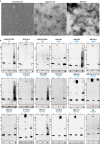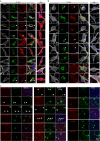Development and validation of an expanded antibody toolset that captures alpha-synuclein pathological diversity in Lewy body diseases
- PMID: 38062007
- PMCID: PMC10703845
- DOI: 10.1038/s41531-023-00604-y
Development and validation of an expanded antibody toolset that captures alpha-synuclein pathological diversity in Lewy body diseases
Erratum in
-
Author Correction: Development and validation of an expanded antibody toolset that captures alpha-synuclein pathological diversity in Lewy body diseases.NPJ Parkinsons Dis. 2024 Jan 11;10(1):19. doi: 10.1038/s41531-024-00634-0. NPJ Parkinsons Dis. 2024. PMID: 38212333 Free PMC article. No abstract available.
Abstract
The abnormal aggregation and accumulation of alpha-synuclein (aSyn) in the brain is a defining hallmark of synucleinopathies. Various aSyn conformations and post-translationally modified forms accumulate in pathological inclusions and vary in abundance among these disorders. Relying on antibodies that have not been assessed for their ability to detect the diverse forms of aSyn may lead to inaccurate estimations of aSyn pathology in human brains or disease models. To address this challenge, we developed and characterized an expanded antibody panel that targets different sequences and post-translational modifications along the length of aSyn, and that recognizes all monomeric, oligomeric, and fibrillar aSyn conformations. Next, we profiled aSyn pathology across sporadic and familial Lewy body diseases (LBDs) and reveal heterogeneous forms of aSyn pathology, rich in Serine 129 phosphorylation, Tyrosine 39 nitration and N- and C-terminal tyrosine phosphorylations, scattered both to neurons and glia. In addition, we show that aSyn can become hyperphosphorylated during processes of aggregation and inclusion maturation in neuronal and animal models of aSyn seeding and spreading. The validation pipeline we describe for these antibodies paves the way for systematic investigations into aSyn pathological diversity in the human brain, peripheral tissues, as well as in cellular and animal models of synucleinopathies.
© 2023. The Author(s).
Conflict of interest statement
H.A.L. is the co-founder and chief scientific officer of ND BioSciences, Epalinges, Switzerland, a company that develops diagnostics and treatments for neurodegenerative diseases (NDs) based on platforms that reproduce the complexity and diversity of proteins implicated in NDs and their pathologies. H.A.L. has received funding from industry to support research on neurodegenerative diseases, including Merck Serono, UCB, and Abbvie. These companies had no specific role in the conceptualization, preparation, and decision to publish this manuscript. H.A.L. is the associate editor of
Figures






References
-
- Spillantini, M. G. et al. Filamentous a-synuclein inclusions link multiple system atrophy with Parkinson’s disease and dementia with Lewy bodies. Neurosci. Lett.251, 205–208 (1998). - PubMed
Grants and funding
LinkOut - more resources
Full Text Sources
Other Literature Sources

